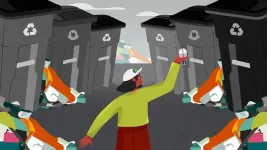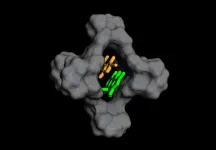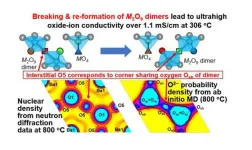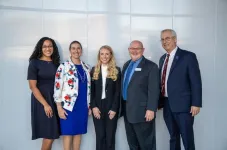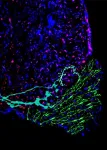(Press-News.org) Bio-based plastics such as polylactic acid (PLA) were invented to help solve the plastic waste crisis, but they often end up making waste management more challenging. Because these materials look and feel so similar to conventional, petroleum-based plastics, many products end up not in composters, where they break down as designed, but instead get added to the recycling stream by well-intentioned consumers. There, the products get shredded and melted down with the recyclable plastics, bringing down the quality of the mixture and making it harder to manufacture functional products out of recycled plastic resin. The only solution, currently, is to try to separate the different plastics at recycling facilities. Yet even with the most high-end, automated sorting tools, some biobased plastics end up contaminating the sorted streams.
Scientists at Lawrence Berkeley National Laboratory (Berkeley Lab) and the Joint BioEnergy Institute (JBEI) are collaborating with X – the moonshot incubator led by Alphabet, Google’s parent company – to not only skip the problematic separation step, but also make the final product better for the planet.
The team has invented a simple “one pot” process to break down mixtures of petroleum-based and bio-based plastics using naturally derived salt solutions paired with specialized microbes. In a single vat, the salts act as a catalyst to break the materials down from polymers, large structures of repeating molecules bonded together, into the individual molecules called monomers, which the microbes then ferment into a new type of biodegradable polymer that can be made into fresh commodity products. The process is described in a One Earth paper published November 17.
“It’s sort of ironic because the purpose of using bio-based plastics is to be more sustainable, but it’s causing problems,” said first author Chang Dou, a senior scientific engineering associate at the Advanced Biofuels and Bioproducts Process Development Unit (ABPDU) at Berkeley Lab. Dou was recently named as one of the American Institute of Chemical Engineer’s 35 Under 35. “Our project is trying to get around the separation issue and make it so you don’t have to worry about whether you mix your recycling bin. You can put all the plastic in one bucket.”
In addition to streamlining recycling, the team’s approach could enable bio-based manufacturing of other valuable products using the same bacteria that are happily munching on plastic monomers. Imagine a world where biofuels or even medicines could be made from plastic waste – of which there is about 8.3 billion tons sitting around in landfills.
“There is an open discussion on whether we can use waste plastics as a carbon source for biomanufacturing. It is a very advanced idea. But we proved that using waste plastics, we can feed microbes. With more genetic engineering tools, microbes might be able to grow on multiple types of plastics at the same time. We foresee the potential to continue this study where we can replace the sugars, traditional carbon sources for microbes, with the processed hard-to-recycle mixed plastics that can be converted to valuable products through fermentation,” said Zilong Wang, a UC Berkeley postdoctoral researcher working at JBEI.
The Berkeley Lab scientists’ next step is to experiment with other organic salt catalysts to try to find one that is both highly effective at breaking polymers down and can be reused in multiple batches to lower costs. They are also modeling how the process would work at the large scales of real-world recycling facilities.
In their recent paper, the scientists demonstrated the potential of their approach in laboratory bench-scale experiments with mixtures of polyethylene terephthalate (PET) – the most common petroleum-based plastic, used in things like water bottles and spun into polyester fibers – and PLA, the most common bio-based plastic.
They used an amino-acid-based salt catalyst previously developed by colleagues at JBEI and a strain of Pseudomonas putida engineered by scientists at Oak Ridge National Laboratory. This combination successfully broke down 95% of the PET/PLA mixture and converted the molecules into a type of polyhydroxyalkanoate (PHA) polymer. PHAs are a new class of biodegradable plastic substitutes designed to efficiently break down in a variety of natural environments, unlike petroleum-based plastics.
Team member Hemant Choudhary noted that although their chemical recycling process is currently only proven for PET plastics contaminated with biodegradable PLA, it would still be beneficial for the diverse plastic streams encountered in real recycling facilities. “It can be completely integrated with existing plastic sources,” said Choudhary, a Sandia National Laboratories staff scientist working at JBEI. Most commercial products are not just one kind of plastic, but a handful of different kinds combined, he explained. For example, a fleece jacket is made with PET-based polyesters alongside polyolefins or polyamides. “We can throw it in our one-pot process and easily process the polyester component from that mixture and convert it into a bioplastic. These monomers are soluble in water, but the leftover parts, the polyolefins or polyamides, are not.” The leftovers can be easily removed by simple filtration and then sent off for a traditional mechanical recycling process where the material is shredded and melted, said Choudhary.
“Chemical recycling has been a hot topic, but it’s difficult to make it happen at the commercial scale because all the separation steps are so expensive,” said Ning Sun, a staff scientist at the ABPDU, lead author, and principal investigator of this project. "But by using a biocompatible catalyst in water, the microbes can directly convert the depolymerized plastics without extra separation steps. These results are very exciting, although we acknowledge that a number of improvements are still needed to realize the economic viability of the developed process.”
Co-authors Nawa R. Baral and Corinne Scown, experts in technoeconomic analysis in JBEI and Berkeley Lab’s Biosciences Area, also demonstrated that once optimized with a reusable salt solution, the process could reduce the cost and carbon footprint of PHAs by 62% and 29%, respectively, compared with today’s commercial PHA production.
JBEI is a Department of Energy (DOE) Bioenergy Research Center managed by Berkeley Lab. The ABPDU is a collaboration facility supported by the DOE BioEnergy Technologies Office.
# # #
Founded in 1931 on the belief that the biggest scientific challenges are best addressed by teams, Lawrence Berkeley National Laboratory and its scientists have been recognized with 16 Nobel Prizes. Today, Berkeley Lab researchers develop sustainable energy and environmental solutions, create useful new materials, advance the frontiers of computing, and probe the mysteries of life, matter, and the universe. Scientists from around the world rely on the Lab’s facilities for their own discovery science. Berkeley Lab is a multiprogram national laboratory, managed by the University of California for the U.S. Department of Energy's Office of Science.
DOE's Office of Science is the single largest supporter of basic research in the physical sciences in the United States, and is working to address some of the most pressing challenges of our time. For more information, please visit energy.gov/science.
END
CAMBRIDGE, MA -- Diagnosing sleep disorders such as sleep apnea usually requires a patient to spend the night in a sleep lab, hooked up to a variety of sensors and monitors. Researchers from MIT, Celero Systems, and West Virginia University hope to make that process less intrusive, using an ingestible capsule they developed that can monitor vital signs from within the patient’s GI tract.
The capsule, which is about the size of a multivitamin, uses an accelerometer to measure the patient’s breathing rate and heart rate. In addition to diagnosing sleep apnea, the device could also be useful for detecting ...
About The Study: Among outpatient adults with mild to moderate COVID-19, treatment with fluvoxamine 100 mg twice daily for 13 days, compared with placebo, did not improve time to sustained recovery in this randomized clinical trial of 1,175 participants.
Authors: Susanna Naggie, M.D., M.H.S., of the Duke University School of Medicine in Durham, North Carolina, is the corresponding author.
To access the embargoed study: Visit our For The Media website at this link https://media.jamanetwork.com/
(doi:10.1001/jama.2023.23363)
Editor’s Note: Please see the article for additional information, ...
About The Study: In this study of 155,000 births, using a causal inference framework based on target trial emulation, birth at 39 weeks’ gestation was not associated with adverse numeracy and literacy outcomes at school age compared with birth at 40 to 42 weeks.
Authors: Roxanne Hastie, Ph.D., of the University of Melbourne, is the corresponding author.
To access the embargoed study: Visit our For The Media website at this link https://media.jamanetwork.com/
(doi:10.1001/jamanetworkopen.2023.43721)
Editor’s Note: Please see the article for ...
About The Study: In this study of state laws, there was substantial heterogeneity in National Instant Criminal Background Check System (NICS) reporting requirements for mental health prohibitions for firearm possession and a lack of clarity around processes. This raises questions about the ability of NICS to be used to block firearm purchases or possession by individuals with court-identified high risk of perpetrating violence toward themselves or others.
Authors: Marian E. Betz, M.D., M.P.H., of the University of Colorado Anschutz Medical Campus School of Medicine in Aurora, is the ...
There is a well-known relationship between good physical fitness at a young age and a lower risk of cardiovascular disease later in life. However, when researchers adjusted for familial factors by means of sibling analysis, they found a weaker association, although the link between high body mass index (BMI) and cardiovascular disease remained strong. The study, which was conducted by researchers from Karolinska Institutet and other universities, is published in JAMA Network Open.
“This does not mean that fitness is irrelevant,” ...
Old people who follow a Mediterranean diet are at a lower risk of cognitive decline, according to a study published in the journal Molecular Nutrition and Food Research. The study provides new evidence for a better understanding of the biological mechanisms related to the impact of the diet on cognitive health in the ageing population.
The study is led by Mireia Urpí-Sardá, adjunct lecturer and member of the Biomarkers and Nutritional & Food Metabolomics research group of the Faculty of Pharmacy and Food Sciences, the Institute for Nutrition and Food Safety (INSA-UB), the Food and Nutrition Torribera Campus of the University of Barcelona, and the CIBER on Frailty and ...
The vision system, evolved over millions of years, is highly complex. To make vision sensitive throughout the whole range of visible wavelengths, Nature employs a supramolecular chemistry approach. The visual pigment, cis-retinal, changes its shape upon capturing a photon. This shape transformation is accompanied by changes in the supramolecular organization of the surrounding proteins, subsequently triggering a cascade of chemical signaling events that get amplified and eventually lead to visual perception in the brain.
“Some deep-sea fish have evolved antenna-like ...
The remarkable proton and oxide-ion (dual-ion) conductivities of hexagonal perovskite-related oxide Ba7Nb3.8Mo1.2O20.1 are promising for next-generation electrochemical devices, as reported by scientists at Tokyo Tech. The unique ion-transport mechanisms they unveiled will hopefully pave the way for better dual-ion conductors, which could play an essential role in tomorrow’s clean energy technologies.
Clean energy technologies are the cornerstone of sustainable societies, and solid-oxide fuel cells (SOFCs) and proton ceramic fuel cells (PCFCs) are among the most promising types of electrochemical devices for green power generation. These devices, however, still ...
MOREHEAD, Ky. (Nov. 17, 2023) — In celebration of National Rural Health Day, yesterday the University of Kentucky College of Medicine and Anthem Blue Cross and Blue Shield Medicaid in Kentucky announced new scholarship opportunities for UK’s Rural Physician Leadership Program (RPLP). The Anthem Rural Medicine Scholarships will provide $100,000 to offset the cost of medical school for students in the RPLP.
In a state that suffers from high rates for many chronic, ...
Unlike humans, zebrafish can completely regenerate their hearts after injury. They owe this ability to the interaction between their nervous and immune systems, as researchers led by Suphansa Sawamiphak from the Max Delbrück Center now report in the journal Developmental Cell.
Each year, more than 300,000 people in Germany have a myocardial infarction – the technical term for heart attack. The number of people surviving a heart attack has increased significantly, but this severe cardiac event causes irreparable damage to their hearts. A heart attack ...
